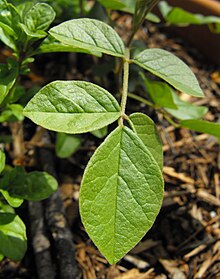Glycyrrhiza uralensis
| Glycyrrhiza uralensis | |
|---|---|

| |
| Scientific classification | |
| Kingdom: | Plantae |
| Clade: | Tracheophytes |
| Clade: | Angiosperms |
| Clade: | Eudicots |
| Clade: | Rosids |
| Order: | Fabales |
| Family: | Fabaceae |
| Subfamily: | Faboideae |
| Genus: | Glycyrrhiza |
| Species: | G. uralensis
|
| Binomial name | |
| Glycyrrhiza uralensis | |
| Synonyms[1] | |
| |
Glycyrrhiza uralensis, also known as Chinese liquorice,[2] is a flowering plant native to Asia. It is used as a sweetener and in traditional Chinese medicine.[3]
Traditional uses[]
This section needs more medical references for verification or relies too heavily on primary sources. (July 2012) |
Liquorice root, or 'radix glycyrrhizae', is one of the 50 fundamental herbs used in traditional Chinese medicine, where it has the name gancao (kan-tsao; Chinese: 甘草, pinyin: gāncǎo). It is used in Chinese medicine to harmonize other herbs and to reduce the harsh effects of other herbs.[3] It is usually collected in spring and autumn, when it is removed from the rootlet and dried in the sun. Liquorice root is most commonly produced in the Shanxi, Gansu and Xinjiang regions of China.[4]
Side effects[]
Liquorice root contains glycyrrhizin, which may affect blood pressure, blood potassium levels or have untoward effects during pregnancy.[5] Overuse of licorice may induce weakness, headache, blurred vision, nosebleed, anxiety, or shortness of breath.[6] Other common side effects may include missed menstrual periods, fluid retention or sexual problems in men.[6]
See also[]
- Chinese herbology 50 fundamental herbs
- Liquorice
References[]
- ^ The Plant List: A Working List of All Plant Species, retrieved 7 March 2017
- ^ "Glycyrrhiza uralensis". Germplasm Resources Information Network (GRIN). Agricultural Research Service (ARS), United States Department of Agriculture (USDA). Retrieved 30 August 2011.
- ^ a b Plants for a Future, retrieved 8 March 2017
- ^ “Gan Cao.” Chinese Medical Herbology and Pharmacology. "Archived copy" (PDF). Archived (PDF) from the original on 2016-03-31. Retrieved 2010-07-20.CS1 maint: archived copy as title (link). 25 April 2010.
- ^ "Licorice Root". National Center for Complementary and Integrative Health, US National Institutes of Health. 1 September 2016. Retrieved 1 April 2019.
- ^ a b "Licorice". Drugs.com. 14 October 2018. Retrieved 1 April 2019.
External links[]
- Spice Pages: liquorice (Glycyrrhiza glabra/uralensis, liquorice)
- Science Direct
- Journal of Chinese Integrative Medicine[permanent dead link]
- Radix Glycyrrhizae at damo-qigong.net
- Plants used in Ayurveda
- Plants used in traditional Chinese medicine
- Glycyrrhiza